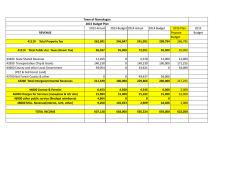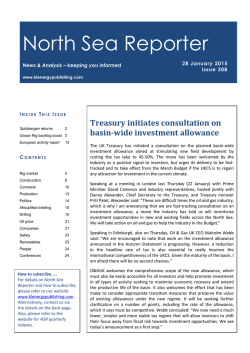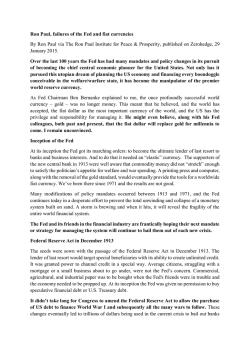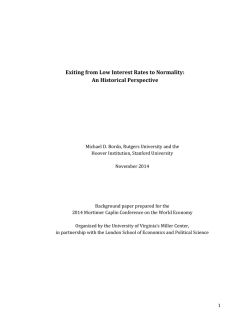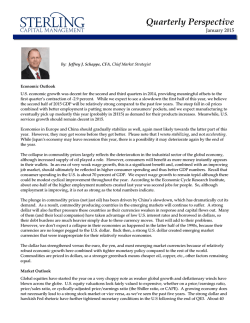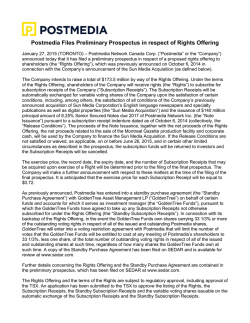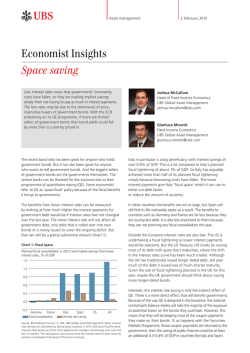
Outside the Box
2015 Investment Themes JOHN MAULDIN | January 28, 2015 “If it ain’t broke, don’t fix it,” says my friend Gary Shilling as he kicks off today’s Outside the Box. He’s referring to his investment themes for 2015. He first gives us 11 reasons to continue favoring long Treasury bonds. That’s an obvious play for him if you know his view, but it’s nevertheless a compelling one this year and one that you should think through, given the specter of deflation about in the world, the firing up of QE in Japan and Europe (which gives folks money to buy … Treasurys), and the safe-haven status of the US dollar. Gary’s reason #9 for buying Treasurys is that “The odds of a near-term Fed rate hike are receding. He sees any Fed rate increase being pushed out “as the deflationary effects of the oil price plunge sink in and investors – and the Fed – realize that foreign central bank stimuli amount to Fed tightening [in relative terms].” Gary’s remaining themes for 2015 include some other clear winners like the US dollar and Japanese equities (no surprise there), but also some interesting defensive plays like consumer staples and foods and what Gary calls “small luxuries.” Be sure to see the special offer for Gary Shilling’s INSIGHT at the conclusion of the letter. An interesting thing happened last week. I get a lot of email from readers and do try and sift through them. I got a very kind note from one reader who thanked me for the introductions we do for Outside the Box – he said they compel him to read the articles, which he finds useful. Of course, that one made me feel good. Then less than an hour later I got a polite note from another reader who complained about my introductions, because he prefers to just jump right in, without my stealing any of the author’s thunder. Both comments made me think more about the process of bringing OTBs to you, which is also good. Sometimes we just do things out of habits that have accreted over time, and I may need to be more aware of what I am actually presenting. I really do appreciate your feedback, positive or constructive. This has been an extremely busy week, as the entire Mauldin Economics team has been in my home for the past three days, sharing ideas, shooting videos, making plans. That means I get a little behind on some things, but being with smart, creative people really gets my juices flowing. Outside the Box is a free weekly economic e-letter by best-selling author and renowned financial expert, John Mauldin. You can learn more and get your free subscription by visiting www.mauldineconomics.com 1 Tonight is sushi with even more guests (and Neil Howe is in town). More planning and meetings and more things that get added to my to-do list. But it is all fun and exciting. You have a great week, and now let’s look at Gary’s investing themes for 2015. Your overwhelmed with ideas analyst, John Mauldin, Editor Outside the Box 2015 Investment Themes (Excerpted from the January 2015 edition of A. Gary Shilling’s INSIGHT) Our 2015 investment themes are quite similar to our 2014 list that worked well for us. If it ain’t broke, don’t fix it. The Treasury “bond rally of a lifetime” still seems intact. The “risk on” investment climate for U.S. equities persists, but as in 2014, we approach it with trepidation and with a defensive portfolio position. The U.S. economy is continuing to grow but at subpar rates (Chart 1) while growth in China is slowing, is very sluggish in the eurozone and negative in Japan. Outside the Box is a free weekly economic e-letter by best-selling author and renowned financial expert, John Mauldin. You can learn more and get your free subscription by visiting www.mauldineconomics.com 2 The dollar is reigning supreme (Chart 2)—and 2015 may turn out to be the year of the greenback as almost every other currency declines against the buck, especially the euro and yen. Commodity prices may drop much further, especially petroleum, while financial problems in Russia, Venezuela and elsewhere escalate severely. Deflation is spreading worldwide and may expand beyond the energy sector to prices in general. And low-quality bonds here and abroad are likely to keep declining as are emerging market stocks. Here are our 13 investment themes for 2015. 1. Treasury bonds. There are many reasons why we continue to favor long Treasury bonds. Here are 10: 1. Safe haven. Like the U.S. dollar, Treasurys are a safe haven in times of global turmoil and uncertainty, of which there are plenty today. 2. Deflation, extant in many countries (Chart 3) and looming in many others including the eurozone, makes current Treasury note and bond yields attractive. Outside the Box is a free weekly economic e-letter by best-selling author and renowned financial expert, John Mauldin. You can learn more and get your free subscription by visiting www.mauldineconomics.com 3 3. Quantitative Ease, underway in Japan and likely soon in the eurozone, provides money to invest in U.S. Treasurys. Outside the Box is a free weekly economic e-letter by best-selling author and renowned financial expert, John Mauldin. You can learn more and get your free subscription by visiting www.mauldineconomics.com 4 4. Treasury yields are attractive relative to those abroad. The 2.17% yield on the 10-year Treasury note vastly exceeds the 0.54% yield on 10-year German bunds, 0.33% for 10-year Japanese governments (Chart 4) and almost every other developed country 10-year sovereign (Chart 5). With the new round of QE in Japan and impending QE in the eurozone, the BOJ and ECB will be buying more government securities, sending yields even lower. The U.S. government obligation is probably at least as high quality as any of these others, and the rising dollar against the euro and yen enhances the appeal to foreigners of buying U.S. debt. What are we missing? Outside the Box is a free weekly economic e-letter by best-selling author and renowned financial expert, John Mauldin. You can learn more and get your free subscription by visiting www.mauldineconomics.com 5 5. Foreigners are buying Treasurys. In the December sale of $13 billion in 30-year Treasurys, indirect bids, a measure of foreign demand, took 50%. The Fed is no longer adding to its Treasury portfolio but foreigners, as well as domestic investors, are more than replacing Fed purchases. With half of Treasurys owned abroad, it is truly a global market. 6. U.S. banks are buying Treasurys as they move away from lower-quality assets, in part to comply with new rules requiring the biggest banks to hold more liquid assets and 60% of these must be backed by the federal government. Also, in counting towards liquid assets, corporate obligations get a 50% haircut but those backed by the full faith and credit of the federal government get 100% credit. 7. Long Treasurys continue to be attractive to pension funds and life insurance that want to match their long-maturity liabilities with similar duration assets. 8. Junk and corporate bonds are losing favor vs. Treasurys. The spreads between junk vs. Treasurys are widening as Treasurys rally while junk bonds sell off under the weight of heavy issues and investor worries about defaults, especially on weak energy company issues. At the same time, the spreads between Treasury and investment-grade yields are widening. Note that energy bonds represent about 20% of most fixedincome benchmarks. Companies are issuing debt at the fastest rate on record, often to fund dividends and share buybacks. Meanwhile, the issuance of Treasurys is shrinking as the federal deficit falls (Chart 6). Unlike the ECB, which is likely to buy corporate debt, the Fed is highly unlikely to do so. This pushes money from U.S. corporates to those in Europe. 9. The odds of a near-term Fed rate hike are receding. Early last year, the futures markets assigned a high probability to an increase by year’s end. Now these markets indicate that the odds are receding, with a 24% probability of an initial Fed rate increase by June and 51% by July. And these numbers will no doubt be pushed out further as the deflationary effects of the oil price plunge sink in and investors—and the Fed— realize that foreign central bank stimuli amount to Fed tightening, relatively. Outside the Box is a free weekly economic e-letter by best-selling author and renowned financial expert, John Mauldin. You can learn more and get your free subscription by visiting www.mauldineconomics.com 6 After its December policy meeting, the Fed said it would be “patient” before raising interest rates, adding that the overall outlook hadn’t changed much from earlier assurances that its policy rates would stay at essentially zero for a “considerable time.” Fifteen of the 17 policy committee members expect rates to rise this year and their median forecast was for 1.125% in 12 months through December, 2.5% in 2016 and 3.625% in 2017. As we’ve noted in past Insights, however, in recent years they’ve consistently forecast stronger economic growth and quicker rises in interest rates than have materialized. Of course, the Fed is right in step with private forecasters. The Wall Street Journal’s poll of 49 forecasters (not including us) back in January 2014 found that 48 expected yields in the 10-year Treasury note to rise from 2.9% at that time to an average forecast of 3.5% by year’s end. It moved in the opposite direction and ended 2014 at 2.17%, as noted earlier. We continue to believe it will be years before the Age of Deleveraging ends and, with it, slow growth, and the Fed shifting to selling securities and raising rates. The recent nosedive in commodity prices and deflationary implications will probably stretch out the central bank’s time line. But what if, contrary to our forecast, the Fed raises its benchmark rate before the Age of Deleveraging is completed? When it hinted at tapering its then-$85 billion in monthly asset purchases in May and June of 2013, Treasury note and bond yields leaped. Nevertheless, these moves were out of keeping with history. Interest rates rose in the post-World War II era up until 1981 as inflation rates climbed, but have fallen since then with receding inflation. After removing these trends, first up and then down, we examined the relationship between the Fed benchmark, the federal funds rate, and the yields on both 10-year Treasury notes and 30-year bonds. On average, the spillover from federal funds was small, with a one percentage-point rise pushing up the 10-year note yield by 0.35 percentage points and the 30-year bond yield by just 0.23 points. So, we don’t expect a nosedive in Treasury note and bond prices even if the Fed tightens credit earlier than we forecast—unless the 2013 Taper Tantrum marked the beginning of a new relationship. Recall, however, the sage words of Sir John Templeton: “The most dangerous words in the English language are, this time it’s different.” 10. Postwar babies are aging and this favors Treasurys as older people reduce the riskiness of their portfolios and favor high-quality bonds, despite low yields. 11. Speculators are increasingly short the benchmark 10-year Treasury note in the futures market. If the rally in Treasury prices persists, sooner or later they will be forced to buy back their shorts, adding to demand. More Treasury Rally Ahead We expect a further rally in Treasury prices with the 30-year yield dropping from the current 2.75% to 2.0%, perhaps by the end of 2015. If so, the Long Bond would provide a total return of 18.8% and the 30-year zero coupon bond, 24.6%. If the 10-year note yield drops from the current 2.17% to 1.0%, as we forecast, the total return would be 12.4%. These may seem like big gains for yield declines of only about one percentage point, but that’s what happens when yields are low. In any event, we believe that “the bond rally of a lifetime” marches on. Outside the Box is a free weekly economic e-letter by best-selling author and renowned financial expert, John Mauldin. You can learn more and get your free subscription by visiting www.mauldineconomics.com 7 2. Selected income-producing securities, including investment-grade corporate and municipal bonds as well as utilities and other stable high dividend-paying stocks, remain attractive. In fact, with municipal bonds on average yielding more than Treasurys, they are very attractive to bond buyers who concentrate on yields, especially on an after-tax basis (Chart 7). Furthermore, the yields on investmentgrade corporates and munis are almost the same, after adjusting corporate yields for the minimum 39% individual income tax rate, and even higher in many states. U.S. stocks are expensive. The Fed’s largess, which we believe was behind the rally that started in March 2009, is no longer there with the end of QE (Chart 8). The leap in the price-earnings ratio that accounted for 67% of the 29.6% rise in the S&P 500 in 2013 is no longer present, and at 19 at present, it is well above the long-term average of 15.5. Outside the Box is a free weekly economic e-letter by best-selling author and renowned financial expert, John Mauldin. You can learn more and get your free subscription by visiting www.mauldineconomics.com 8 3. Consumer staples and foods. We favor these stocks, but defensively, advocating things that people buy regardless of economic circumstances—utilities, consumer staples and health care—in sectors that also tend to have attractive dividend yields. 4. Selected healthcare providers benefit from the increasing health care needs of aging postwar babies as well as the newly insured under Obamacare. Medical office buildings continue to be attractive as physicians migrate to hospitals from stand-alone practices in view of increasing regulatory costs. 5. Low P/E stocks with meaningful dividends also fit into our defensive category. 6. Small luxuries, things that financially-stressed consumers buy to get the best of what they can afford, also is defensive and benefits from the many Americans and people abroad who still have compressed incomes, including in developing countries. Global consumer products companies like Unilever and Proctor & Gamble are finding that poor people in countries like India with static or even declining wages and little discretionary income will still pay more for fancier soap, shampoo, razors and mouthwash. 7. Productivity enhancers should continue to thrive as slow sales growth and lack of market acceptance of higher raise prices keep businesses focused on cost-cutting and productivity improvement. 8. Japanese stocks remain attractive as the Abe government strives to stimulate economic growth while trashing the yen. 9. The dollar continues to look profitable vs. the loonie, kiwi, Aussie (Chart 9) and other commodity currencies as commodity prices, led by oil, keep dropping along with the deliberately-trashed yen and euro. Virtually all currencies are being devalued against the dollar, which, as the world’s reserve and major trading currency, can’t really be devalued. It’s a matter of other currencies falling against the greenback, the established norm, not the buck rising against them. Outside the Box is a free weekly economic e-letter by best-selling author and renowned financial expert, John Mauldin. You can learn more and get your free subscription by visiting www.mauldineconomics.com 9 The euro looks especially vulnerable as the chasm between the Teutonic North, led by Germany, and the Club Med South, spearheaded by France, continues to widen. Labor reform efforts and other measures to improve efficiency in the Italian government and private sectors continue to meet huge resistance, and the Italian economy is back in recession. Meanwhile, economic growth is trivial and government debt levels huge (Chart 10). Greece is facing another national election with the anti-eurozone Syriza Party showing strength. We seldom make explicit forecasts for investment themes because we seldom know how far investments moving in our favor will go. In the case of the euro, however, it’s interesting to note that it started out in 1999 with the dollar worth about 1.10 euros (Chart 11). It dropped to 0.85 in May 2001 before climbing to 1.58 in March 2008. Since then, it’s been on a downward trend. With all the problems in the eurozone and ECB President Draghi’s determination to devalue the currency, the euro might well drop back to 1.00, or parity with the greenback this year. Outside the Box is a free weekly economic e-letter by best-selling author and renowned financial expert, John Mauldin. You can learn more and get your free subscription by visiting www.mauldineconomics.com 10 Similarly, the yen could drop substantially from here. Note in Chart 12 that in November 1982, it hit 278 per dollar. That’s a long way from the current 120, and a collapse to 278 would be a disaster for Japan and the whole world. Still, given the newly-re-elected Abe’s determination to trash the yen, it’s reasonable to see the yen dropping to 150 or 200 per greenback. Notice that Abe used his re-election momentum recently to recommend a corporate tax cut from 34.6% to 32.1% in the fiscal year starting in April and to 31.3% in the following fiscal year. Unattractive Themes Our unattractive themes list includes 10. Industrial commodities, especially copper (Chart 13), which we love to short. As in 2014, we’re refraining from shorting crude oil because of uncertainty over OPEC actions and the outcome of the Saudis’ game of chicken with weak OPEC producers as well as American frackers. Outside the Box is a free weekly economic e-letter by best-selling author and renowned financial expert, John Mauldin. You can learn more and get your free subscription by visiting www.mauldineconomics.com 11 We do, however, continue to list 11. Natural gas as a short because of the spillover from oil and the abundance created by U.S. fracturing—at least until LNG exports become substantial. It goes without saying that we’ve dropped our North American energy theme on the attractive side. 12. Emerging country stocks and bonds continue to be unattractive, in our view. With developing countries that depend on oil exports in deep trouble and other commodity exporters such as Brazil in doubtful positions, this whole investment sector is under pressure with both stock and government bond prices falling on average of late (Chart 14). 13. Junk bonds (Chart 15) continue to be interesting on the short side, especially those issued by energyrelated companies. The rest may well be dragged down as investors flee to safe havens. Outside the Box is a free weekly economic e-letter by best-selling author and renowned financial expert, John Mauldin. You can learn more and get your free subscription by visiting www.mauldineconomics.com 12 A Shock In past Insights, we’ve explored the Grand Disconnect between slowly-growing major economies and soaring equity markets, propelled by central bank money and, in the U.S., by unsustainable corporate costcutting as well. This gap will get closed sooner or later, either by Fed tightening and the recession that has followed in 11 of 12 similar incidences in the post-World War II era, or a substantial shock that will have the same effect. The resulting recession will no doubt become global, given the already weak state of many foreign economies and financial structures. We also stated that it will be years before the Age of Deleveraging and slow economic growth are concluded, and the Fed then begins to raise interest rates and shrink or sterilize the $2.3 trillion in excess member bank reserves that have accumulated with QE. So a major shock may occur before the Fed shifts gears toward credit restraint. The obvious current possibility, of course, is the financial fallout from the ongoing weakness in commodity prices, especially crude oil, and the soaring greenback. In “Past External Financial Shocks and Their Effects” (also in our January 2015 Insight report), we examine the effects of past shocks on the U.S. economy, going back to the 1973 Arab oil embargo. The dollar was up over 7% last year against emerging economy currencies, and about $1 trillion in their corporate bonds were issued before the buck surged. So the cost of servicing those dollar debts is climbing, much as in the late 1990s when a similar problem with government dollar issues precipitated the Asian financial crisis that led to defaults in many Far Eastern economies as well as Russia, Brazil and Argentina. Last year, companies in emerging markets issued almost $280 billion in dollar-denominated bonds to take advantage of low interest costs. Governments have joined this parade but not as extensively as in the late 1990s. Still, total company and sovereign debt issuers had $6 trillion in outstanding bonds at the end of 2014, up four times since the 2008 financial crisis. As investors retreat from these emerging markets to dollars, local currencies will fall even further. The Indonesian rupeah, Chilean peso, Brazilian real and Turkish lira are near multi-year lows and the Mexican central bank recently spent $200 million to support its peso. The IMF and Bank for International Settlements worry that exchange rate problems could sire corporate defaults and asset price busts worldwide. In any event, a major shock and resulting recession would shift the investment climate from the current “risk on” to “risk off,” emphasizing what we call the Quartet—Treasurys and the dollar would be attractive as safe havens while equities of all types, be they in developed, developing or frontier markets, would be dumped along with commodities. Interestingly, three of the four members of the Quartet are already on the stage and beginning to play. Treasurys are leaping in price. The dollar is soaring against almost every foreign currency. And commodity prices are plummeting. Only stocks are yet to enter the stage and tune down. Outside the Box is a free weekly economic e-letter by best-selling author and renowned financial expert, John Mauldin. You can learn more and get your free subscription by visiting www.mauldineconomics.com 13 SUBSCRIBE TO GARY SHILLING’S INSIGHT AND YOU’LL RECEIVE THE DETAILS ON ALL OF HIS INVESTMENT THEMES FOR 2015. SUBSCRIBE TO INSIGHT FOR ONE YEAR FOR $335 VIA E-MAIL ($375 VIA REGULAR MAIL) AND YOU’LL RECEIVE A FREE COPY OF THE JANUARY 2015 INSIGHT THAT LAYS OUT IN DETAILALL OF OUR INVESTMENT THEMES FOR THIS YEAR. AND THEN YOU’LL RECEIVE 12 MONTHS OF INSIGHT, STARTING WITH THE FEBRUARY 2015 REPORT. TO SUBSCRIBE, CALL US AT 1-888-346-7444 OR 973-467-0070. OR E-MAIL US AT [email protected]. BE SURE TO MENTION OUTSIDE THE BOX TO GET YOUR FREE COPY OF OUR JANUARY 2015 INSIGHT THAT DETAILS ALL OF GARY SHILLING’S INVESTMENT THEMES. (THIS OFFER AVAILABLE ONLY TO NEW SUBSCRIBERS) Copyright 2015 John Mauldin. All Rights Reserved. Share Your Thoughts on This Article Post a Comment Like Outside the Box? Then we think you’ll love John’s premium product, Over My Shoulder. Each week John Mauldin sends his Over My Shoulder subscribers the most interesting items that he personally cherry picks from the dozens of books, reports, and articles he reads each week as part of his research. Learn more about Over My Shoulder Outside the Box is a free weekly economic e-letter by best-selling author and renowned financial expert, John Mauldin. You can learn more and get your free subscription by visiting http://www.mauldineconomics.com. Please write to [email protected] to inform us of any reproductions, including when and where copy will be reproduced. You must keep the letter intact, from introduction to disclaimers. If you would like to quote brief portions only, please reference http://www.mauldineconomics. com. To subscribe to John Mauldin’s e-letter, please click here: http://www.mauldineconomics.com/subscribe/ To change your email address, please click here: http://www.mauldineconomics.com/change-address If you would ALSO like changes applied to the Mauldin Circle e-letter, please include your old and new email address along with a note requesting the change for both e-letters and send your request to [email protected]. To unsubscribe, please refer to the bottom of the email. Outside the Box is a free weekly economic e-letter by best-selling author and renowned financial expert, John Mauldin. You can learn more and get your free subscription by visiting www.mauldineconomics.com 14 Outside the Box and JohnMauldin.com is not an offering for any investment. It represents only the opinions of John Mauldin and those that he interviews. Any views expressed are provided for information purposes only and should not be construed in any way as an offer, an endorsement, or inducement to invest and is not in any way a testimony of, or associated with, Mauldin’s other firms. John Mauldin is the Chairman of Mauldin Economics, LLC. He also is the President of Millennium Wave Advisors, LLC (MWA) which is an investment advisory firm registered with multiple states, President and registered representative of Millennium Wave Securities, LLC, (MWS) member FINRA, SIPC. MWS is also a Commodity Pool Operator (CPO) and a Commodity Trading Advisor (CTA) registered with the CFTC, as well as an Introducing Broker (IB) and NFA Member. Millennium Wave Investments is a dba of MWA LLC and MWS LLC. This message may contain information that is confidential or privileged and is intended only for the individual or entity named above and does not constitute an offer for or advice about any alternative investment product. Such advice can only be made when accompanied by a prospectus or similar offering document. Past performance is not indicative of future performance. Please make sure to review important disclosures at the end of each article. Mauldin companies may have a marketing relationship with products and services mentioned in this letter for a fee. Note: Joining the Mauldin Circle is not an offering for any investment. It represents only the opinions of John Mauldin and Millennium Wave Investments. It is intended solely for investors who have registered with Millennium Wave Investments and its partners at www.MauldinCircle.com or directly related websites. The Mauldin Circle may send out material that is provided on a confidential basis, and subscribers to the Mauldin Circle are not to send this letter to anyone other than their professional investment counselors. Investors should discuss any investment with their personal investment counsel. John Mauldin is the President of Millennium Wave Advisors, LLC (MWA), which is an investment advisory firm registered with multiple states. John Mauldin is a registered representative of Millennium Wave Securities, LLC, (MWS), an FINRA registered broker-dealer. MWS is also a Commodity Pool Operator (CPO) and a Commodity Trading Advisor (CTA) registered with the CFTC, as well as an Introducing Broker (IB). Millennium Wave Investments is a dba of MWA LLC and MWS LLC. Millennium Wave Investments cooperates in the consulting on and marketing of private and non-private investment offerings with other independent firms such as Altegris Investments; Capital Management Group; Absolute Return Partners, LLP; Fynn Capital; Nicola Wealth Management; and Plexus Asset Management. Investment offerings recommended by Mauldin may pay a portion of their fees to these independent firms, who will share 1/3 of those fees with MWS and thus with Mauldin. Any views expressed herein are provided for information purposes only and should not be construed in any way as an offer, an endorsement, or inducement to invest with any CTA, fund, or program mentioned here or elsewhere. Before seeking any advisor’s services or making an investment in a fund, investors must read and examine thoroughly the respective disclosure document or offering memorandum. Since these firms and Mauldin receive fees from the funds they recommend/market, they only recommend/market products with which they have been able to negotiate fee arrangements. PAST RESULTS ARE NOT INDICATIVE OF FUTURE RESULTS. THERE IS RISK OF LOSS AS WELL AS THE OPPORTUNITY FOR GAIN WHEN INVESTING IN MANAGED FUNDS. WHEN CONSIDERING ALTERNATIVE INVESTMENTS, INCLUDING HEDGE FUNDS, YOU SHOULD CONSIDER VARIOUS RISKS INCLUDING THE FACT THAT SOME PRODUCTS: OFTEN ENGAGE IN LEVERAGING AND OTHER SPECULATIVE INVESTMENT PRACTICES THAT MAY INCREASE THE RISK OF INVESTMENT LOSS, CAN BE ILLIQUID, ARE NOT REQUIRED TO PROVIDE PERIODIC PRICING OR VALUATION INFORMATION TO INVESTORS, MAY INVOLVE COMPLEX TAX STRUCTURES AND DELAYS IN DISTRIBUTING IMPORTANT TAX INFORMATION, ARE NOT SUBJECT TO THE SAME REGULATORY REQUIREMENTS AS MUTUAL FUNDS, OFTEN CHARGE HIGH FEES, AND IN MANY CASES THE UNDERLYING INVESTMENTS ARE NOT TRANSPARENT AND ARE KNOWN ONLY TO THE INVESTMENT MANAGER. Alternative investment performance can be volatile. An investor could lose all or a substantial amount of his or her investment. Often, alternative investment fund and account managers have total trading authority over their funds or accounts; the use of a single advisor applying generally similar trading programs could mean lack of diversification and, consequently, higher risk. There is often no secondary market for an investor’s interest in alternative investments, and none is expected to develop. All material presented herein is believed to be reliable but we cannot attest to its accuracy. Opinions expressed in these reports may change without prior notice. John Mauldin and/or the staffs may or may not have investments in any funds cited above as well as economic interest. John Mauldin can be reached at 800-829-7273. Outside the Box is a free weekly economic e-letter by best-selling author and renowned financial expert, John Mauldin. You can learn more and get your free subscription by visiting www.mauldineconomics.com 15
© Copyright 2025
